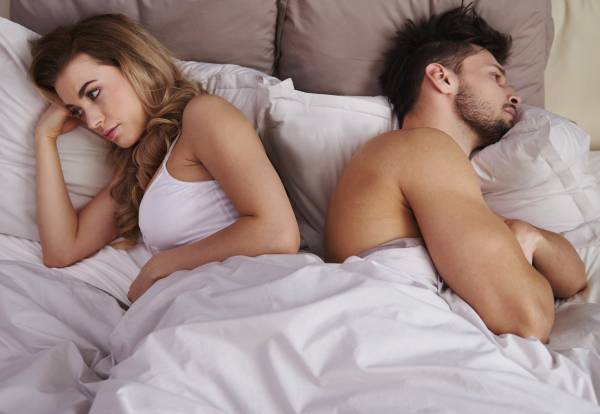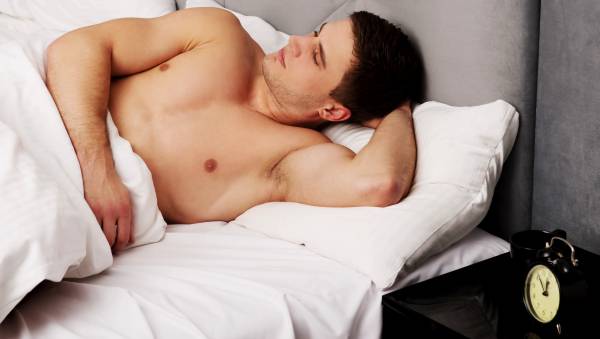For fitness enthusiasts, there’s always a new gadget to help us measure performance or monitor rest and recovery. Increasingly, many people are using something like heart rate variability (HRV) monitoring or even taking monthly blood tests to look at markers of stress and inflammation.
But what if I told you that most of us could get enough information for free and with no needles? All you need to do is answer the following question:
Are you hard enough?
For fitness enthusiasts, there’s always a new gadget to help us measure performance or monitor rest and recovery. Increasingly, many people are using something like heart rate variability (HRV) monitoring or even taking monthly blood tests to look at markers of stress and inflammation.
But what if I told you that most of us could get enough information for free and with no needles? All you need to do is answer the following question:
Are you hard enough?
The human male likes to think he’s ready for anything. And that includes sex. To be more specific, there are certain areas at the front of his brain, such as the nucleus accumbens, which drive him to seek out the pleasure of sexual interaction.1
For that pleasure to be achieved, the brain obviously requires other parts of the anatomy to cooperate, which can only happen when physiology and biochemistry are within the normal range. This is also what we need when we’re looking for better performance.
So what’s the easiest way to assess optimal physiology in the hard-charging male? A soldier standing resolutely at attention. A sail raised with a sturdy mast. More specifically, a well-pitched tent first thing in the morning. You get the picture.
If you exercise regularly and your mornings aren’t particularly glorious, you might need to rethink your training.
Morning Glory
As well as being a source of endless sexual euphemism, morning glory does actually have a scientific name – sleep-related erection (SRE).2 SRE is also known as nocturnal penile tumescence, but that’s difficult to say with a straight face.
Technically, SREs also include the erections you have while you’re asleep, but unless you frequently poke your partner in the eye throughout the night, you’re generally less aware of those.
Sleep-related erections occur during rapid eye movement (REM) sleep. SREs start as we enter the REM phase of our sleep cycle and last until the next cycle of non-REM sleep.3
“Importantly, it turns out that morning glory could be a surprisingly good way to monitor both hormone levels and health in adult males.”
In the adult male, SREs are linked to levels of testosterone, with testosterone production also peaking during REM sleep.4
As testosterone levels drop, frequency of SREs declines.5 The same phenomenon is seen in most male mammals, and monitoring of SREs has even been used to look at REM sleep in babies while still in the uterus.6 But try not to think about that last point too much.
Importantly, it turns out that morning glory could be a surprisingly good way to monitor both hormone levels and health in adult males.
For instance, if you find yourself wrestling to aim at the toilet every morning, you’re probably nicely situated at the top of this bell curve:

I know, it looks suspiciously like the Yerkes-Dodson “arousal” curve. Coincidence?
However, if you exercise regularly and your mornings haven’t been particularly glorious recently, it’s likely you’re not finding the balance between training and recovery.
At the other end of the scale (not enough exercise), there’s also a drop off as health deteriorates, which could be reversed with closer attention to activity and lifestyle.
Running the Lead Out of Your Pencil
The negative effects of pushing yourself too hard in training are well understood, but something we often ignore. It’s easy to think you’re not achieving your health and body composition goals because you’re not working hard enough.
But this feeling you are not putting in the work is often not a situation that can be fixed by more training or more dieting.
Few of us have the luxury of multiple training sessions per day or, in fact, the time to train every day, but this does not mean we aren’t at risk of overtraining.
“[T]here’s a reason they say training for an Ironman is an excellent form of contraception. And it’s not just because your wife doesn’t like the look of you in Lycra.”
In this context, overtraining is simply having the stress of training overwhelm all the other stuff going on in your life, like sleep, nutrition, and stresses at home or at work.7
Think about this: just four weeks of 1,000-calorie-per-day energy deficit (despite eating 3,000-4,000 calories per day) accompanied by only four hours of sleep per night is enough to make available testosterone levels drop by ninety percent, with total testosterone well below the level at which frequency of morning glory would drop off (around 200ng/dl or 7nmol/l).4,5
This drop-off may sound extreme, but for the hard-working man with a couple of kids and a stressful job who is also trying to regain the six-pack of his youth, this is much more common than you’d think.
The oxidative stress and hormonal imbalances due to high-volume endurance training in particular are associated with lower sperm quality and may increase the risk of male infertility.8
After all, there’s a reason they say training for an Ironman is an excellent form of contraception. And it’s not just because your wife doesn’t like the look of you in Lycra.

Oxidative stress and hormonal imbalances due to high-volume endurance training in particular are associated with lower sperm quality and may increase the risk of male infertility.
Not Enough of a Good Thing
As well as a good dose of testosterone, there’s something else you need if you want to head for your morning shower with your very own towel rail. Flow.
“If you find yourself feeling soft during periods of intense training, consider either reducing your training volume or making sure you’re eating and sleeping enough to recover adequately.”
Like every organ in the body, your manhood requires good blood flow. Because the blood vessels “down there” are very sensitive, SREs (morning glory) can be a surprisingly easy way to monitor health.
For instance, erectile function is a good predictor of current cardiovascular problems you might not be aware of , as well as future risk of heart attacks and strokes.3,9,10
In men who aren’t active, increasing physical activity also results in improved erectile function.11
Approaching exercise in a step-wise fashion beginning with just brisk walking will increase testosterone levels and reduce the risk of heart disease, diabetes, and obesity.12 It doesn’t take much to be a hard man.
Caveats
As SREs occur during REM sleep, they won’t necessarily be around if you wake up regularly from deep (non-REM) sleep using an alarm clock. An easy way to check would be to treat yourself to sleeping in once in a while. You deserve it.
“A quick look down in the morning can give you a good idea of how your body is adapting to an increased training load or other changes and stresses in your life.”
Both testosterone and frequency of SREs decrease as we age, but this tends to happen in line with other chronic diseases.3 Therefore, if you’re smart about training and nutrition, you can expect many decades of glorious mornings to come.

An easy way to check your SRE status would be to treat yourself to sleeping in once in a while. You deserve it.
Peak Performance
A quick look down in the morning can give you a good idea of how your body is adapting to an increased training load or other changes and stresses in your life.
More exercise will benefit those who fall to the left-hand side of the bell curve, but you can have too much of a good thing. If you find yourself feeling soft during periods of intense training, consider either reducing your training volume or making sure you’re eating and sleeping enough to recover adequately.8,13,14,15
Remember, for optimal performance, you want to place yourself firmly in the middle of the graph – at the top of the bell. In other words, you want make sure you’re always right on the bell-end. This will make sure you perform better on the streets, as well as between the sheets.
You’ll Also Enjoy:
References:
1. Blum et al. Sex, drugs, and rock ‘n’ roll: hypothesizing common mesolimbic activation as a function of reward gene polymorphisms. J Psychoactive Drugs. 2012 Jan-Mar;44(1):38-55.
2. van Driel. “Sleep-related erections throughout the ages.” J Sex Med. 2014 Jul;11(7):1867-75.
3. Hirshkowitz and Schmidt. “Sleep-related erections: clinical perspectives and neural mechanisms.” Sleep Med Rev. 2005 Aug;9(4):311-29.
4. Evans et al. “Concentrations of plasma testosterone in normal men during sleep.” Nature. 1971 Jan 22;229(5282):261-2.
5. Granata et al. “Relationship between sleep-related erections and testosterone levels in men.” J Androl. 1997 Sep-Oct;18(5):522-7.
6. Koyanagi et al. “REM sleep determined using in utero penile tumescence in the human fetus at term.” Biol Neonate. 1991;60 Suppl 1:30-5.
7. Brooks and Carter. “Overtraining, Exercise, and Adrenal Insufficiency.” J Nov Physiother. 2013 Feb 16;3(125).
8. du Plessis et al. “Is There a Link between Exercise and Male Factor Infertility?” Open Repro Sci J 2011, 3, 105-113 105.
9. Karacan et al. “Erectile dysfunction in hypertensive men: sleep-related erections, penile blood flow and musculovascular events.” J Urol. 1989 Jul;142(1):56-61.
10. Rastrelli et al. “Impaired masturbation-induced erections: a new cardiovascular risk factor for male subjects with sexual dysfunction.” J Sex Med. 2013 Apr;10(4):1100-13.
11. Simon et al. “The Association of Exercise with Both Erectile and Sexual Function in Black and White Men.” J Sex Med. 2015 Mar 20.
12. Tommy Wood, The Great Upside-Down Movement Pyramid, Breaking Muscle
13. Veldhuis et al. “Amplitude suppression of the pulsatile mode of immunoradiometric luteinizing hormone release in fasting-induced hypoandrogenemia in normal men.” J Clin Endocrinol Metab. 1993 Mar;76(3):587-93.
14. Leproult and Van Cauter. “Effect of 1 week of sleep restriction on testosterone levels in young healthy men.” JAMA. 2011 Jun 1;305(21):2173-4.
15. Spiegel et al. Impact of sleep debt on metabolic and endocrine function. Lancet. 1999 Oct 23;354(9188):1435-9.
Photos courtesy of Shutterstock.
